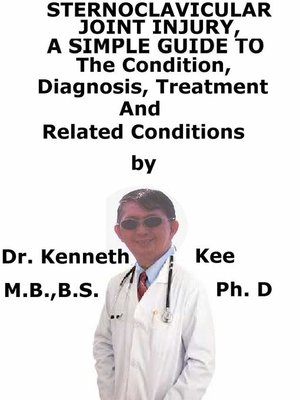Sternoclavicular Joint Injury, a Simple Guide to the Condition, Diagnosis, Treatment and Related Conditions
ebook
By Kenneth Kee

Sign up to save your library
With an OverDrive account, you can save your favorite libraries for at-a-glance information about availability. Find out more about OverDrive accounts.
Find this title in Libby, the library reading app by OverDrive.



Search for a digital library with this title
Title found at these libraries:
| Library Name | Distance |
|---|---|
| Loading... |
This book describes Sternoclavicular Joint Injury, Diagnosis and Treatment and Related Diseases
The Sternoclavicular Joint is a very strong joint that provides the main skeletal connection between the axial skeleton and the upper limb.
The Sternoclavicular Joint is stable due to its very strong supporting ligaments from the clavicle to the sternum.
Sternoclavicular joint injuries are featured by injury to the sternoclavicular joint and surrounding structures.
Almost invariably traumatic in cause, they vary in severity from a mild sprain to complete disruption.
Injuries to the sternoclavicular joint (SCJ) are relatively rare, being responsible for less than 5% of shoulder girdle injuries.
People who have slack joint ligaments (often "double-jointed") are more likely to dislocate the SCJ.
After a traumatic incident the joint may become less stable and keep popping out (unstable) or stay dislocated (locked dislocation)
Sternoclavicular joint injuries are categorized into 3 grades:
1. First degree injury: a simple sprain, due to an incomplete rupture or stretching of the sterno-clavicular and costo-clavicular ligaments.
This is the most frequent form of sterno-clavicular joint injury.
2. Second degree injury: the clavicle sub-luxes either anteriorly or posteriorly from its manubrial attachment, producing a total tear of the sternoclavicular ligament but at most, only a partial tear of the costo-clavicular ligament
3. Third degree injury: a complete tear of the sternoclavicular and costoclavicular ligaments, permitting a total dislocation of the clavicle from the manubrium.
Injuries and osteoarthritis are the most frequent disorders linked with the SC joint.
Injuries to the SC joint can differ from a mild sprain, in which the surrounding ligaments are stretched (the most often observed injury), to a fracture of the clavicle itself.
In infrequent instances, a strong blow to the shoulder can produce an injury in which the joint dislocates totally from its normal position.
Joint dislocations are categorized as:
1. Anterior—the end of the clavicle is thrust forward, in front of the sternum
2. Posterior—the end of the clavicle is thrust backward, behind the sternum and deep into the upper chest
While both kinds of dislocations are severe injuries, a posterior dislocation needs more urgent medical attention.
In a posterior dislocation, the vital structures behind the SC joint can be pressed upon, causing life-threatening disorders with breathing or blood flow.
Anterior dislocations are much more frequent (by a 9:1 ratio) normally happening from an indirect action, such as a direct blow to the anterior shoulder that rotates the shoulder backwards thus passing the stress on to the sternoclavicular joint.
Posterior dislocations are normally a result of a force pushing the shoulder forwards, or from a direct injury to the superior sternal or medial clavicular surfaces.
Normally, injuries to the joint are produced by some type of high-contact event, such as a:
1. Collision or hard fall during a contact sport like football or rugby
2. Motor vehicle accident
Due to the considerable force required to produce an injury, patients may also have extra injuries to the chest, airways, and extremities.
The diagnosis is often a noticeable painful bump at the sternoclavicular joint and the injury can be confirmed by X-rays or CT scan.
The initial treatment is to try to put the joint back into place (reduction).
In some patients, the closed reduction for a posterior dislocation is not effective.
In this setting, the...







